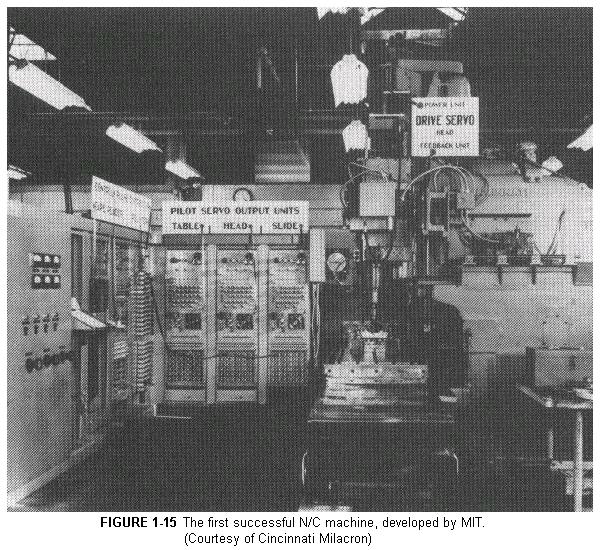Where Did N/C Come From?
 N/C's roots go back to the 1720s when the Jacquard loom was devised that used holes in punched cards to control the decorative patterns woven into the cloth. Perhaps a more familiar ancestor of numerical control is the player piano (Figure 1.14). Originating in the 1860s, player pianos use a roll of punched paper to control the actuation of the keys and notes.
N/C's roots go back to the 1720s when the Jacquard loom was devised that used holes in punched cards to control the decorative patterns woven into the cloth. Perhaps a more familiar ancestor of numerical control is the player piano (Figure 1.14). Originating in the 1860s, player pianos use a roll of punched paper to control the actuation of the keys and notes.
Numerical control as we know it today started out before the advent of the microprocessor used in contemporary computers. The U.S. Air Force is generally credited with being the prime force in the development of N/C. The introduction of the turbojet engine permitted a considerable increase in the speed of combat aircraft, which resulted in increased stresses on aircraft structural members. The structural members became more geometrically complex to withstand the increased forces and required more complex machining, at greater cost.
The first successful N/C machine, funded by the Air Force, was demonstrated by the Massachusetts Institute of Technology in 1952. It was a "retrofitted" Cincinnati milling machine (Figure 1.15). It had the ability to coordinate the axis motions to machine a complex surface. The first "commercial" N/C machines were shown at the 1955 National Machine Tool Show.

The first generation of N/C machines used large vacuum-tube-based controllers that consumed a great deal of electrical power, generated a lot of heat, occupied a large area of floor space, and left much to be desired with respect to to reliability. Second-generation models replaced the vacuum tubes with transistors for increased reliability, decreased power consumption, and to occupy less space. Third-generation models featuring integrated circuitry and modular circuit design reduced costs and increased reliability still further.
As advances in technology continued, special preprogrammed circuit boards were added to perform many of the commonly used routines. These routines, called canned cycles performed cyclic operations such as drilling, boring, and tapping.
These first- and second-generation controllers had no memory. The controller had to be "fed" its instructions, one at a time, from an external source, a tape reader (Figure 1.16). The controller would accept a single instruction (or command), execute that command, accept the next command, execute it, accept another command, etc.

The commands were encoded on a paper tape. As the tape passed through the tape reader, a single block of information--the command--would be read and passed on to the controller for execution. After execution, the controller would signal the tape reader that it was ready for another command. The tape reader would then read the next block, and so on, until the entire tape was read, passed on to the controller, and executed. The last command on the tape was a code to cause the reader to rewind the tape. The first command on the tape was a code to tell the tape reader when to stop rewinding to prevent the front end of the tape from coming off the supply reel. Although N/C machines like this are no longer being made, a number of these machines are still in use.

Back to Contents Page
Updated Jan. 9, 2002
Copyright © 1988-2002 by George Stanton and
Bill Hemphill
All Rights Reserved
 N/C's roots go back to the 1720s when the Jacquard loom was devised that used holes in punched cards to control the decorative patterns woven into the cloth. Perhaps a more familiar ancestor of numerical control is the player piano (Figure 1.14). Originating in the 1860s, player pianos use a roll of punched paper to control the actuation of the keys and notes.
N/C's roots go back to the 1720s when the Jacquard loom was devised that used holes in punched cards to control the decorative patterns woven into the cloth. Perhaps a more familiar ancestor of numerical control is the player piano (Figure 1.14). Originating in the 1860s, player pianos use a roll of punched paper to control the actuation of the keys and notes.

